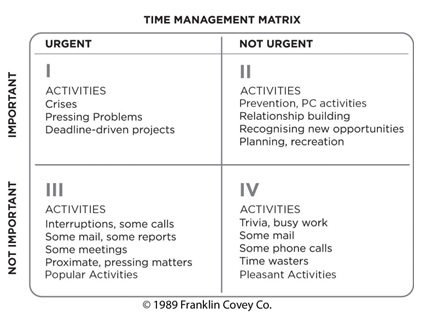Nearly all leaders lack enough hours in the day to get everything done. A constant barrage of emails, calls, texts and social media only increases the pressure and demands urgent attention.
The key word is ‘urgent’. By understanding the significant difference between urgency and importance, leaders can manage their time more effectively and accomplish more of their priorities.
FranklinCovey co-founder, Dr Stephen R Covey, first articulated the idea of urgency versus importance in his highly influential book The 7 Habits of Highly Effective People®. Adopted by leaders worldwide, these enduring principles have become more relevant than ever given the increasing complexity and demands of life in the twenty-first century.
Dr Covey maintained that individuals can begin to increase their effectiveness by becoming more proactive and not relying on others to shape their lives. They should also clarify what they need to achieve, which he called ‘beginning with the end in mind’.
Recognising the practical challenge of time in achieving these priorities, Dr Covey created a matrix that outlines the four ways we spend our time, according to how important and urgent they are.
The Four Quadrants of Time Management

- Quadrant I – High Importance/High Urgency. Activities in this exciting but stressful quadrant include emergency meetings, last-minute deadlines and pressing problems.
- Quadrant II – High Importance/Low Urgency. This quadrant contains activities that leaders recognise as important but rarely seem to complete, such as strategic thinking, planning, prevention and learning.
- Quadrant III – High Urgency/Low Importance. This quadrant contains irrelevant meetings, unnecessary reports and reacting to other people’s minor issues – time-sensitive activities that keep people busy but prevent them from accomplishing anything significant.
- Quadrant IV – Low Urgency/Low Importance. Productivity is non-existent in this quadrant which consists of activities that are carried out to excess, often as relief to those who have burnt themselves out in Quadrants I and III.
Leaders take control, deliver results and shape their organisations by spending time in Quadrant II. However, most leaders spend as little as 10% of their time on these activities because more urgent activities demand their attention.
Putting the first things first: making the move to Quadrant II
Moving to Quadrant II enables leaders to fulfil ambitions and achieve their most important priorities, but it requires time, the resource that leaders often lack the most.
Leaders can begin by recognising when they spend time in Quadrants III and IV. These activities are by definition unimportant but win attention by appearing deceptively urgent. Once identified, leaders need to make a conscious effort to say no to activities they know will derail their efforts to focus on more important initiatives.
Saying no to activities that appear urgent is the hardest part of moving to Quadrant II but often acts as a catalyst for wider change. Sharing the framework of urgency versus importance can help others understand how leaders are prioritising their time and often inspires others to follow their example.
As leaders spend more time in Quadrant II focusing on planning and prevention, they find they naturally decrease the amount of time dealing with emergencies and urgent matters in Quadrant I.
The importance of planning
Planning is a key tool for any leader making the shift to Quadrant II. Leaders should set aside time once a week to organise and schedule Quadrant II activities. Daily planning tends to prioritise urgent activities.
Leadership should remember not to prioritise what’s on their schedule but rather to schedule their priorities, which typically consist of short-term weekly goals, longer-term organisational objectives and personal priorities. Scheduling time for QII activities in a weekly diary puts first things first. Spending half of the week in QII leaves enough time to deal with the unanticipated activity that inevitably comes a leader’s way.
A planning tool should be a servant, not a master. The most effective leaders stay flexible, occasionally rescheduling Quadrant II activity to attend to urgent and important priorities that arise unexpectedly. Quadrant I activities are, after all, important too.
Remember the important thing
Finding time to lead is ultimately about making time, not trying to do more. This starts with leaders managing themselves more effectively.
Leaders who can recognise the activities that are deceptively urgent but ultimately unimportant can more easily focus on what truly matters. These leaders accomplish more of what matters most to themselves and their organisations.
© 2014. Franklin Covey Co. All rights reserved.





